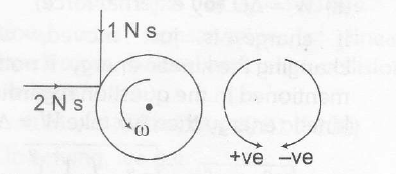Answer:
Option A,C
Explanation:
The data is incomplete. Let us assume that friction from ground on ring is not
impulsive during impact.
From linear momentum conservation in horizontal direction, we have
$(2 \times 1)+(0.1 \times 20)= (0.1 \times 0)+(2 \times v) \leftarrow^{-v}\rightarrow^{+ve}$
Here, v is the ve;locity of CM of ring after impact
Solving the above equation, we have
u=0
Thus, CM becomes stationary.
$\therefore$ correct answer is (a)
Linear impulse during impact
(i) In horizontal direction
$J_{1}=\triangle P=0.1 \times v20=2Ns$
(ii) In vertical direction
$J_{2}=\triangle P = 0.1 \times 10 =1 Ns$

Writing the equation (about CM)
Angular impulse= change in angular momentum
$1\times\left(\frac{\sqrt{3}}{2}\times\frac{1}{2}\right)-2\times0.5\times\frac{1}{2}$
$=2\times(0.5)^{2}\left[ \omega-\frac{1}{0.5}\right]$
Solving this equation ω comes out to be positive or ω anti-clockwise. So just after collision rightwards slipping is taking place.
Hence, friction is leftwards.
Therefore, option (c) is also correct
Correct options are (a) and (c).